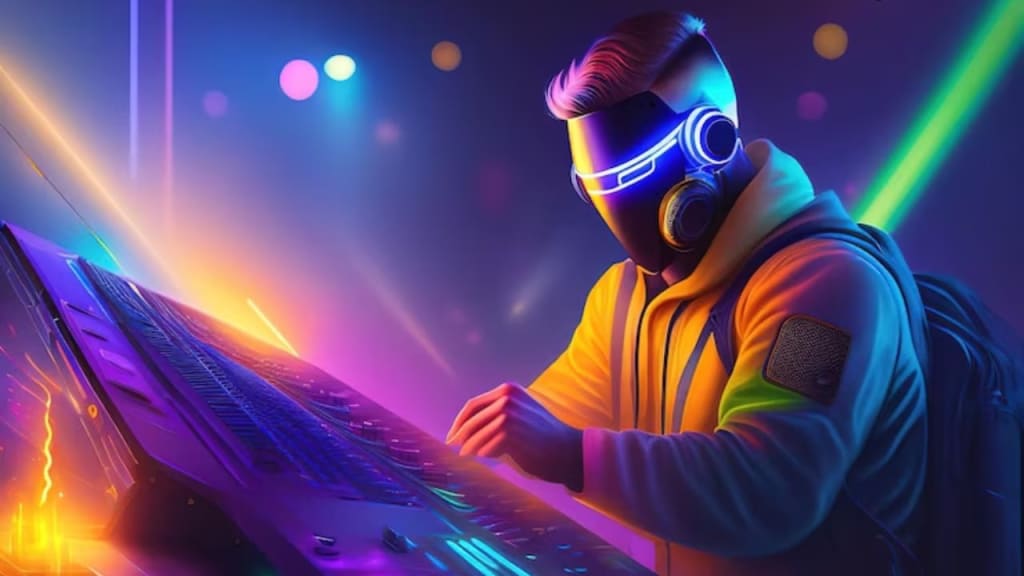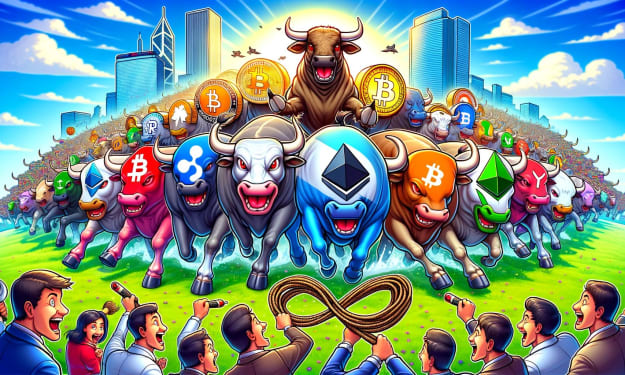Blockchain Game Development - Understanding Decentralized Marketplaces in Blockchain Games
Exploring the Benefits of Asset Ownership in Blockchain Games

Blockchain technology is a decentralized and transparent system for recording and verifying transactions across multiple computers or nodes. It is often referred to as a "distributed ledger" because it enables participants to maintain a shared database without relying on a central authority.
At its core, a blockchain is a chain of blocks, where each block contains a list of transactions. These transactions are grouped and added to the blockchain sequentially and permanently. Once a block is added to the chain, it cannot be altered or removed without consensus from the network participants.
The unique feature of blockchain technology lies in its consensus mechanism. Instead of relying on a central authority to validate transactions, blockchains use consensus algorithms, such as Proof of Work (PoW) or Proof of Stake (PoS), to ensure agreement among the participants. These algorithms require network participants to solve complex mathematical puzzles or stake a certain amount of cryptocurrency to validate and add new blocks to the chain.
Blockchain technology provides several benefits, including:
- Transparency: The entire transaction history is recorded on the blockchain and can be viewed by anyone, promoting trust and accountability.
- Security: Each block is linked to the previous one using cryptographic techniques, making it difficult for malicious actors to tamper with the data.
- Decentralization: Blockchains operate on a network of computers, eliminating the need for a central authority and reducing the risk of a single point of failure.
- Immutable and auditable records: Once a block is added to the blockchain, it becomes extremely difficult to alter, providing a reliable and auditable record of transactions.
- Potential for smart contracts: Blockchain platforms, like Ethereum, support the execution of self-executing smart contracts, enabling automation and programmability within the blockchain network.
Blockchain technology has gained popularity beyond its original application in cryptocurrencies. It has found applications in various industries, including finance, supply chain management, healthcare, voting systems, and more. Its ability to provide secure and transparent transactions has the potential to revolutionize numerous sectors and enhance efficiency and trust in digital interactions.
Understanding Blockchain in Gaming
Blockchain technology has also made its way into the gaming industry, offering new possibilities and benefits for both players and developers. When applied to gaming, blockchain can introduce features like asset ownership, decentralized marketplaces, provable scarcity, and play-to-earn opportunities.
One of the key advantages of blockchain in gaming is the concept of asset ownership. Traditionally, game assets such as in-game items, characters, or virtual currencies are owned and controlled by the game developers. With blockchain, these assets can be tokenized and stored on the blockchain, allowing players to have true ownership and control over their digital possessions. This ownership enables players to freely trade, sell, or even loan their assets to others, fostering a player-driven economy.
Additionally, blockchain introduces decentralized marketplaces where players can buy, sell, and trade their in-game assets directly with other players. These marketplaces eliminate the need for intermediaries, such as centralized gaming platforms, and enable peer-to-peer transactions. Blockchain ensures the security and transparency of these transactions, providing a trustless environment for players to engage in trading activities.
Blockchain also enables the concept of provable scarcity in gaming. Through the use of non-fungible tokens (NFTs), developers can create unique and limited-edition digital assets within games. NFTs are indivisible tokens that can represent items with distinct characteristics, making them rare and collectible. This introduces a sense of exclusivity and value to in-game items, as their scarcity can be verified and proven on the blockchain.
Furthermore, blockchain technology has facilitated the emergence of play-to-earn gaming models. In traditional games, players invest time and effort into playing, but they rarely have the opportunity to earn tangible rewards. However, with blockchain-based games, players can earn cryptocurrencies or in-game tokens that hold real-world value. These tokens can be traded or used within the game ecosystem, providing players with financial incentives and the ability to monetize their gaming experiences.
Overall, blockchain technology in gaming brings transparency, ownership, decentralized economies, and new economic opportunities for players. It has the potential to reshape the gaming landscape by empowering players, creating unique experiences, and offering innovative gameplay mechanics. As the technology continues to evolve, we can expect to see more integration of blockchain in the gaming industry, providing exciting possibilities for gamers and developers alike.
Key Components of Blockchain Game Development
Blockchain game development involves several key components that differentiate it from traditional game development. Here are some essential elements of blockchain game development:
- Blockchain Infrastructure: The foundation of blockchain game development is the underlying blockchain infrastructure. Developers need to choose a suitable blockchain platform that aligns with their game's requirements. Popular choices include Ethereum, EOS, TRON, and others. Each platform has its features, smart contract capabilities, and token standards, which influence the design and functionality of the game.
- Smart Contracts: Smart contracts are self-executing contracts coded on the blockchain. They define the rules and logic of the game, including the creation, ownership, and transfer of in-game assets. Smart contracts ensure transparency, security, and automation of gameplay mechanics. Developers must design and deploy smart contracts that govern the game's core functionalities, such as asset ownership, trading, rewards, and game logic.
- Non-Fungible Tokens (NFTs): NFTs are unique digital assets that can represent in-game items, characters, or other game elements. NFTs enable players to have true ownership and control over their virtual assets. Developers must create and manage NFTs on the blockchain, ensuring their uniqueness and scarcity. These tokens can be traded, bought, and sold on decentralized marketplaces, providing players with opportunities for asset monetization and trading.
- Cryptocurrency Integration: Many blockchain games incorporate cryptocurrencies or in-game tokens as an integral part of their ecosystem. These tokens can be used for in-game purchases, rewards, and economic transactions. Developers must integrate cryptocurrency wallets, payment gateways, and token systems into their games to facilitate seamless transactions and provide a smooth user experience.
- Decentralized Marketplaces: Blockchain games often feature decentralized marketplaces where players can trade and exchange their in-game assets directly with other players. Developers need to create user-friendly marketplaces that connect buyers and sellers, allowing for secure and transparent peer-to-peer transactions. Integration with blockchain technologies like smart contracts and NFT standards ensures the authenticity, ownership, and transferability of assets in these marketplaces.
- Play-to-Earn Mechanics: Play-to-earn is a popular concept in blockchain games where players can earn cryptocurrency or in-game tokens by participating in the game. Developers must design gameplay mechanics and economic systems that reward players for their engagement, skill, or achievements. These rewards can be traded or used within the game ecosystem, providing players with tangible value for their time and effort.
- Community Engagement: Blockchain games often emphasize community involvement and governance. Developers should incorporate features that enable player interaction, collaboration, and decision-making. Community-driven initiatives like voting systems, player feedback mechanisms, and decentralized governance models can enhance player engagement and foster a sense of ownership within the game's ecosystem.
In summary, blockchain game development requires a deep understanding of blockchain infrastructure, smart contracts, NFTs, cryptocurrency integration, decentralized marketplaces, play-to-earn mechanics, and community engagement. By leveraging these components effectively, developers can create innovative and immersive gaming experiences that leverage the benefits of blockchain technology.
Challenges and Limitations in Blockchain Game Development
While blockchain game development offers exciting possibilities, it also presents certain challenges and limitations that developers must consider. Here are some key challenges and limitations in blockchain game development:
- Scalability: Scalability remains a significant challenge in blockchain game development. Most blockchain platforms have limitations in terms of transaction throughput and speed. As games require fast and frequent interactions, scaling the blockchain to handle a large number of players and transactions simultaneously can be a complex task. Developers need to carefully design and optimize their games to ensure smooth gameplay and responsiveness.
- User Experience: Blockchain technology introduces additional steps and complexities compared to traditional games. Interacting with blockchain wallets, executing transactions, and managing cryptographic keys can be daunting for non-technical users. Developers must focus on creating intuitive user interfaces and streamlined onboarding processes to provide a seamless and user-friendly experience.
- Cost and Transactions Fees: Blockchain transactions often incur fees, such as gas fees on Ethereum. These fees can pose challenges for players, especially if they are required to pay fees for each transaction or interaction within the game. Developers need to find a balance between providing a rewarding experience and minimizing the financial burden on players. Optimizing smart contracts and exploring layer-2 scaling solutions can help mitigate high transaction costs.
- Blockchain Limitations: Each blockchain platform has its limitations and constraints. For instance, Ethereum's limitations include high gas fees, limited scalability, and the need for participants to hold Ether for transaction execution. Developers must carefully consider these limitations and design their games accordingly. Exploring alternative blockchain platforms or layer-2 solutions may be necessary to address specific technical constraints.
- Regulatory Considerations: Blockchain technology and cryptocurrencies operate in a regulatory landscape that is still evolving. Compliance with existing regulations, such as anti-money laundering (AML) and know-your-customer (KYC) requirements, can add complexity and overhead to blockchain game development. Developers need to navigate these regulatory challenges and ensure their games comply with applicable laws and regulations in the regions where they operate.
- Adoption and User Base: Despite the growing interest in blockchain games, the user base is still relatively small compared to traditional gaming markets. Developers may face challenges in attracting and retaining a substantial player community. Educating and onboarding new users to blockchain technology and its benefits can be crucial for wider adoption.
- Technical Expertise: Developing blockchain games requires a specialized skill set and understanding of blockchain technology. It may be challenging to find developers with expertise in both game development and blockchain technologies. Building a talented team or collaborating with experienced blockchain developers becomes essential to overcome technical hurdles and ensure the successful implementation of blockchain game projects.
Despite these challenges and limitations, blockchain game development continues to evolve, and solutions are being explored to address these issues. As the technology matures and scalability improves, the potential for blockchain games to offer unique experiences and benefits to players is expected to grow.
Trends and Future Directions in Blockchain Game Development
Blockchain game development is a dynamic field that continues to evolve. Several trends and future directions are emerging in the realm of blockchain games. Here are some notable trends and potential future directions:
- Cross-Platform Compatibility: There is a growing demand for cross-platform blockchain games that can be played seamlessly across different devices and operating systems. Developers are exploring interoperability standards and solutions that allow players to access their game assets and progress from multiple platforms, such as PCs, consoles, mobile devices, and virtual reality (VR) platforms.
- Integration with Web 3.0: Web 3.0, often referred to as the decentralized web, aims to provide a more open, user-centric, and privacy-focused online environment. Blockchain game developers are exploring ways to integrate their games with Web 3.0 technologies, such as decentralized identity solutions, decentralized storage, and decentralized communication protocols. This integration can enhance security, privacy, and user control over their data and digital assets.
- Gaming Metaverses: Metaverses are virtual worlds where players can interact, explore, and engage in various activities. Blockchain technology can play a crucial role in creating decentralized and user-driven metaverses. Developers are envisioning blockchain-based metaverse platforms where players can own, trade, and monetize their virtual assets across different games and experiences. These metaverses can foster social interactions, economies, and collaborative gameplay.
- Enhanced Interoperability: Interoperability between different blockchain networks and gaming ecosystems is gaining attention. Developers are exploring technologies like cross-chain bridges and interoperability protocols to enable seamless asset transfer and interactions between different blockchain games. This interoperability can expand the possibilities for players, allowing them to utilize their assets across multiple games and platforms.
- Integration of DeFi Elements: DeFi (Decentralized Finance) elements are being integrated into blockchain games, enabling players to earn interest, participate in lending and borrowing, or use their in-game assets as collateral for loans. This integration brings additional financial opportunities and incentives to players, creating a deeper integration of gaming and decentralized finance.
- Sustainability and Green Initiatives: As the environmental impact of blockchain networks, especially those using Proof of Work (PoW) consensus mechanisms, has come under scrutiny, developers are exploring alternative consensus mechanisms like Proof of Stake (PoS) or energy-efficient protocols. Sustainability-focused blockchain game projects are emerging, aiming to reduce the carbon footprint associated with blockchain technology while providing immersive gaming experiences.
- Integration of Artificial Intelligence (AI): AI technologies can enhance gameplay experiences in blockchain games. Developers are exploring AI algorithms for various purposes, such as creating dynamic and adaptive game worlds, intelligent non-player characters (NPCs), personalized gaming experiences, and AI-powered virtual assistants to provide guidance and support to players.
- Integration of Augmented Reality (AR) and Virtual Reality (VR): Combining blockchain technology with AR and VR can create immersive and interactive gaming experiences. Developers are exploring the integration of blockchain into AR/VR platforms to enable asset ownership, virtual land ownership, and unique in-game experiences. These technologies can revolutionize the way players interact with digital worlds and enhance immersion.
These trends and future directions highlight the continuous innovation and exploration in blockchain game development. By incorporating these advancements, developers have the opportunity to create groundbreaking gaming experiences, transform player interactions, and push the boundaries of what is possible in the realm of blockchain games.
Conclusion
In conclusion, blockchain technology has introduced significant advancements in the field of game development. It has revolutionized the way players interact with virtual assets, enabled decentralized economies, and opened up new opportunities for earning and ownership. However, blockchain game development also comes with its own set of challenges, including scalability, user experience, and regulatory considerations. Overcoming these challenges requires technical expertise, innovative solutions, and a deep understanding of blockchain and gaming mechanics.
Looking to the future, trends in blockchain game development indicate a movement towards cross-platform compatibility, integration with Web 3.0, the emergence of gaming metaverses, enhanced interoperability, the integration of DeFi elements, sustainability initiatives, AI integration, and the incorporation of AR/VR technologies. These trends will shape the future landscape of blockchain games, offering players more immersive experiences, interconnected gaming worlds, and novel ways to engage with digital assets.
As blockchain technology continues to evolve, it holds the potential to transform the gaming industry by empowering players, fostering decentralized economies, and creating new opportunities for creativity, ownership, and monetization. With ongoing innovation, collaboration, and the integration of cutting-edge technologies, blockchain game development is poised for exciting advancements and an increasingly prominent role in the gaming ecosystem.
About the Creator
Annabelle Darcie
I am an enthusiastic content writer currently involved in NFT marketplace development. I am thrilled to have the opportunity to support and accompany many individuals on their entrepreneurial journey.






Comments
There are no comments for this story
Be the first to respond and start the conversation.